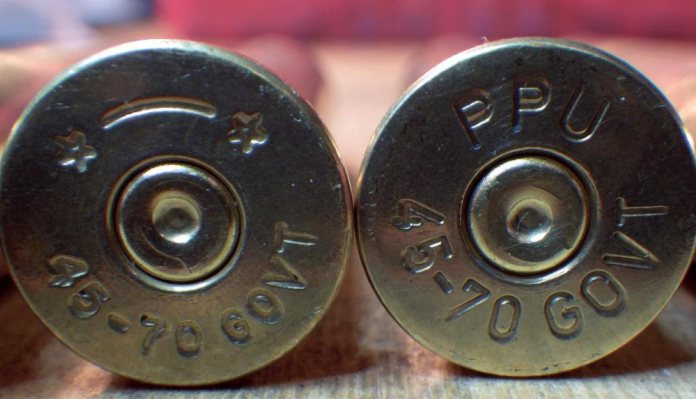Reloaading Basics - Under Pressure
-
0
 Comments
Comments
- Last updated: 27/04/2020

Chamber pressure, and in particular maximum chamber pressure, is something that is always included in reloading data and publications, but any further explanation of just what it represents is sometimes lacking.
The maximum chamber pressure produced by ammunition is generated by the powder inside the case burning and generating a relatively huge volume of gases extremely quickly. Propellants burn at different rates, with some producing those gases much faster than others, and it is always important to use the correct powder for a particular application. The comparative burn rates vary by fractions of milliseconds, but the difference is still very significant.
The hot gases are initially trapped inside the case by the bullet and so the pressure increases extremely rapidly within the volume of the case and this is where the maximum chamber pressure occurs. As well as the size of the powder charge, there are other factors that will have an effect on the maximum pressure reached inside the case. For example, different brands of case have different internal volumes and the smaller the volume the higher the pressure can get. Also, the amount of crimp is a very significant factor as it dictates the level of pressure required to break the bullet free from the case. Cartridge overall length, dictated by how deep the bullet is seated, also effects the size of the available space for the powder to burn inside the case and therefore the pressure that will be created.
When the pressure gets sufficiently high the bullet will leave the case mouth and start to move down the barrel. As the bullet travels forward the space behind it increases giving the trapped gases more room to occupy and so the pressure will start to fall. The pressure will continue to fall as the bullet moves further down the barrel until the point where it leaves the muzzle and pressure drops to zero. With rifle ammunition slower burning powders are used as they will continue to generate pressure after the bullet starts to travel along the barrel and help keep the pressure up as it moves through the longer barrel. In Pistols faster burning powders are used to get the pressure up quicker to get the maximum benefit before the bullet leaves the barrel.
Chamber pressure is one of those things that can be best explained with a picture, or to be more specific, a pressure curve. This is a graph showing chamber pressure against time, in milliseconds, and it generally takes the form of a big spike right away followed by a gradual curve down to zero. The height and width of the spike will obviously vary from calibre to calibre, but the differences are in fractions of milliseconds so hard to perceive. These charts are the best way of presenting chamber pressure in an understandable and clear way.
There are also pressure curves that plot pressure against bullet travel, in inches, and these also show an initial spike in pressure which then drops as the bullet travels further along the barrel. Barrel length does not have any effect on the peak pressure, but it does extend the curve down to the point where the bullet exits the barrel.
The spike at the very beginning of the pressure curve is the most important point as it shows the pressure at its peak, where it is most likely to cause damage to the gun. Reloading software, such as QuickLoad, will show a pressure curve with coloured shading at the higher pressure levels to indicate when the peak of the curve moves towards dangerous levels. If the peak goes into the red area you are exceeding the maximum safe pressure for your particular load.
Pressure curves are a very useful way of explaining how chamber pressure works and how it differs between calibres. They also demonstrate that pressure does not continue to build until the bullet leaves the barrel as some seem to think. For this to happen powder would have to continue to burn and generate pressure for the entire time that the bullet is in the barrel. It is not possible to fit enough powder into a case, and for it to burn sufficiently slowly, for this to work effectively.
These pressure curves are produced by powder and ammunition manufacturers in laboratories with special equipment, not in actual guns, to ensure that their products are safe. Software like QuickLoad uses complex formulas to calculate pressures and generate their pressure curves so the data is therefore theoretical (but based on very stringent and accurate data).
The author runs Quickload to check all types of reloads but still uses published reloading data to ensure the loads are within the manufacturer’s limits.
The actual pressures that occur inside your firearm will probably be different from those stated in reloading data or software because of all of the variables involved. All firearms are produced to take a particular maximum chamber pressure and you must always ensure your ammunition does not exceed that figure. If you are able to access a pressure curve for your chosen load, or generate one of your own using reloading software, it is the best way to visualise and understand maximum chamber pressure, and also ensure you are staying within safe limits.
The knack to getting it right and producing safe ammunition that performs well is making sure the pressure curve is right for the job. The burn rate of the powder, and the rate at which it generates gas, has to suit the volume of the cartridge, the barrel length, the bullet weight and of course the strength of your gun. Sticking to published loading data will ensure you achieve this and stay safe.
